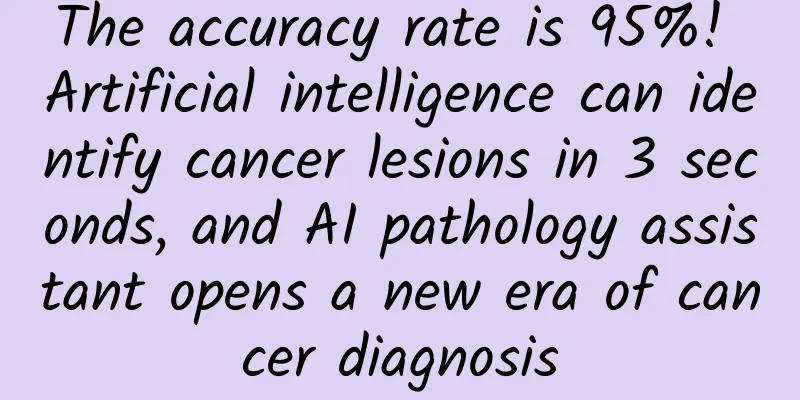The accuracy rate is 95%! Artificial intelligence can identify cancer lesions in 3 seconds, and AI pathology assistant opens a new era of cancer diagnosis

|
In the vast universe of medicine, cancer is like a dark star, threatening human health at all times. However, with the advancement of science and technology, artificial intelligence (AI) is gradually becoming a powerful weapon for us to fight this stubborn disease. Recently, the AI pathology assistant OmniPT, jointly released by Professor Song Mingli's team from the School of Computer Science at Zhejiang University and Professor Zhang Jing's team from the First Affiliated Hospital of Zhejiang University, has brought revolutionary changes to the field of cancer diagnosis with its excellent performance of accurately locking cancer lesions within 1 to 3 seconds. The traditional cancer diagnosis process is full of challenges. When analyzing pathological sections, doctors need to face hundreds of millions of cell images, which is time-consuming and labor-intensive. Long-term reading of films can easily lead to visual fatigue, affecting the accuracy of diagnosis. It is worth noting that the number of diseased cells in early cancer is small, and their morphology is similar to that of normal cells, so the risk of missed diagnosis is extremely high. These difficulties not only test the professional skills of doctors, but also concern the life safety of patients. The advent of OmniPT provides a new approach to solving these problems. This technology integrates visual and language models, can process image and text information simultaneously, and achieves a deep understanding of pathological images. Based on deep learning algorithms and big data analysis, OmniPT has learned to identify the subtle features of cancer lesions through training with a large amount of pathological image data. In more than ten high-incidence cancers such as gastric cancer, colorectal cancer, and cervical cancer, OmniPT has demonstrated a diagnostic accuracy of more than 95%, significantly reducing the risk of missed diagnosis and misdiagnosis. The application of OmniPT not only improves diagnostic accuracy, but also significantly reduces the workload of doctors. The ability to quickly locate cancer lesions allows doctors to devote more time and energy to the formulation of treatment plans and patient care. In addition, accurate cancer diagnosis also provides strong support for personalized treatment, which helps to improve treatment effects and improve patient prognosis. Looking ahead, AI technologies such as OmniPT have broad prospects for application in the medical field. With the continuous iteration and optimization of technologies, we expect these technologies to expand their application scope and achieve broader and deeper medical applications. Interdisciplinary cooperation and innovation will also become a key driving force for the development of medical AI technology. Experts in fields such as medicine, computer science, and data science will work together to explore the infinite possibilities of AI in the medical field. At the same time, the popularization of AI technology is expected to promote the balanced development of global medical resources. Through remote diagnosis, intelligent assistance and other means, medical resources in developed areas can be better radiated to remote areas, improving the global medical level. In addition, the improvement of public health awareness will also become a positive result of the application of AI technology. With people's understanding and recognition of AI technology, health management will be more scientific and systematic, achieving early prevention, early diagnosis and early treatment. However, the application of AI technology in the medical field also brings ethical and legal challenges. Issues such as privacy protection and responsibility attribution need to be discussed and resolved by all sectors of society. While promoting technological development, we should establish a sound data management and protection mechanism to ensure the reasonable and compliant application of technology. The birth of AI pathology assistant OmniPT marks a new era for cancer diagnosis. We have reason to believe that with the continuous advancement of science and technology and the deepening of its application, AI will play a greater role in the medical field and make greater contributions to human health. At the same time, we should also maintain rational thinking, pay attention to the challenges and problems in the development of AI, and jointly promote the sustainable development of the medical industry. In the days to come, let us work together to protect the flower of life with the power of science and technology, and make health a solid foundation for everyone's life. |
<<: Wisdom tooth inflammation warning: How to avoid the "molar crisis"? Remember these points!
Recommend
Increased vaginal discharge before menstruation
In the few days before a woman's menstruation...
Is it really so “difficult” for Clostridium difficile to appear?
Is it really so “difficult” for Clostridium diffi...
How to prevent pregnancy after ejaculation
If a man does not want to get pregnant after ejac...
Artificial ones are better than "original ones". 3D femtosecond laser helps an 82-year-old man regain his youthful vision
Cataracts are not unfamiliar to many middle-aged ...
Introduction to the correct method of breast enhancement
Women are born with a love of beauty. They not on...
Wisdom Teeth Part 2 | What should you pay attention to before and after tooth extraction? Just remember these points sorted out by the dentist~
There is a thing It is called a bug in the histor...
What happens when you lift heavy objects during pregnancy?
Pregnant women need to pay more attention to many...
Female genital surgery
Female vulva plastic surgery is a new discipline ...
Insomnia is not a disease! You must know the truth about insomnia
Sleepless nights, tossing and turning, and being ...
The difference between 30 days and 42 days of confinement
Many people think that confinement is the traditi...
Popular Science on the Past and Present of Cervical Cancer
The past and present of cervical cancer Li Jiangn...
Leucorrhea is thin like water
If the leucorrhea is thin, it is very likely caus...
Why does the lower body pain occur after childbirth?
The short period after giving birth is a painful ...
Women burn calories when having sex
Can sex help you lose weight? Many people think l...









